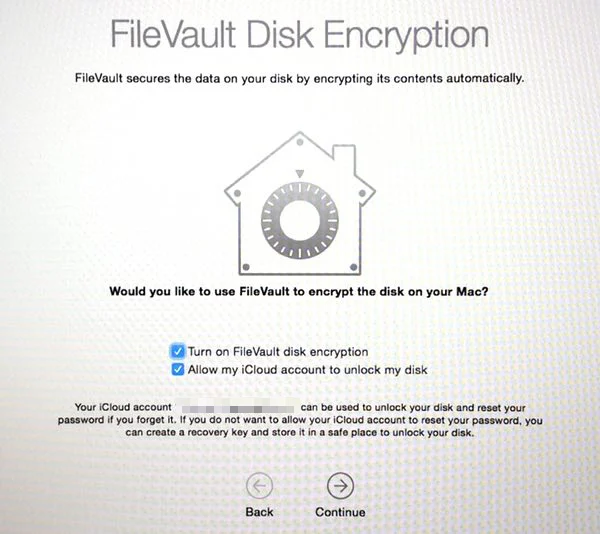

- #MAC OS X ENCRYPTION PROCESS HOW TO#
- #MAC OS X ENCRYPTION PROCESS MAC OS X#
- #MAC OS X ENCRYPTION PROCESS PASSWORD#
- #MAC OS X ENCRYPTION PROCESS FREE#
- #MAC OS X ENCRYPTION PROCESS MAC#
For those reasons, we suggest using a free third-party service, such as TrueCrypt or 7-Zip.Įmail or follow her and Google+. Take any file or folder and add AES-256 encryption to it.
#MAC OS X ENCRYPTION PROCESS MAC#
It works on both Mac and Windows, so you can send encrypted files without worrying whether the other person can open it or not.
:max_bytes(150000):strip_icc()/SystemPreferences-a2a1ce1c1e804e688455c97a9aed7ef2.jpg)
companies to hand over data or encryption keys. Encrypto is a free, easy-to-use app that lets you encrypt files with AES-256 encryption and then send them to friends or coworkers. If you're very serious about security and privacy, you might not trust an Apple solution.
#MAC OS X ENCRYPTION PROCESS PASSWORD#
This is a strong, trustworthy method, but there are some high-level workarounds that a security expert could exploit.įor the average user, the most important thing is choosing a strong user account password that isn't easily guessable. How good is Apple's FileVault 2 encryption?Īpple's FileVault 2 uses an encryption method called XTS-AES 128-bit, which means it encrypts using a string of random characters 128 bits in length. You can create, save and access files just as you used to the encryption is unlocked when you log into your account at sign-in. When you unmount the disk image, the files will be locked and no one will be able to access them unless they have your encryption password.When you next log into your user account, the computer will begin encrypting all of the files on your hard drive. The files will be available to use and any files you save to the disk image will be encrypted. Whenever you want to work with your encrypted files just mount the disk image and enter your password. You can encrypt individual files by creating an encrypted file container, or disk image.
#MAC OS X ENCRYPTION PROCESS HOW TO#
RELATED: How to Create an Encrypted Disk Image to Securely Store Sensitive Files on a Mac The disk will be encrypted once you enter your password of choice-be sure to use a secure one! You may have to wait several minutes for the contents of your disk to be encrypted, depending on the size of your drive and its speed.ĭon’t lose your password! If you do, you won’t be able to access any files on the encrypted drive. Ctrl+click or right-click the drive in the Finder sidebar and select the Encrypt option. Even Safari, Mac’s native web browser, uses an HTML rendering engine from the open-source community.
#MAC OS X ENCRYPTION PROCESS MAC OS X#
Many other components of the Mac OS X are based on open-source software as well 3. To encrypt a drive, simply open the Finder and connect the drive to your Mac. of Mac OS X is built with open-source software called Darwin, an open-source operating system. It functions like BitLocker To Go on Enterprise editions of Windows, but it’s available to all Mac users. The contents of the drive will be encrypted with a passphrase you choose, and no one will be able to access them without that passphrase. With macOS you can also encrypt entire external drives. This can take days, so consider keeping your Mac awake overnight. Once you’re done configuring FileVault, your Mac will begin encrypting your drive in the background. Keep this key somewhere safe, because it’s the only way you can recover your files should you lose access to the local accounts on your Mac with permission to decrypt the drive. If you’d rather not tie your encryption to a (potentially hackable) online account, that’s not a problem: you can opt for a recovery key instead. This allows you to regain access to the drive if you forget the username and password for the local account on your Mac. Click the “Turn On FileVault” option to enable and configure FileVault.īy default, FileVault will ask you for your Apple ID. To enable FileVault, click the Apple icon on the menu at the top of your screen, select System Preferences, and click the Security & Privacy icon. When you enable FileVault2, encryption happens in the background without causing any disruptions to your ability to work. It provides strong encryption for the files and data in a drive. Your drive will be locked again when you shut down your Mac. FileVault2 uses XTS-AES-128 encryption with a 256-bit key and it is available in macOS X 10.7.5 or later. When you turn on your Mac, you’ll have to sign in with one of those user accounts before your drive is unlocked. You can choose which user accounts have the ability to unlock your disk. (Without FileVault enabled, anyone with physical access to your Mac could remove its hard drive and view your files, because they’re stored in an unencrypted form.)

Someone who gains access to your Mac, removes your hard drive, and attempts to view your files won’t be able to see anything without your encryption key. When you enable FileVault, your files are stored on your hard drive in an encrypted, seemingly scrambled format. The FileVault feature allows you to encrypt your Mac’s entire hard disk. RELATED: What Is Encryption, and How Does It Work?


 0 kommentar(er)
0 kommentar(er)
